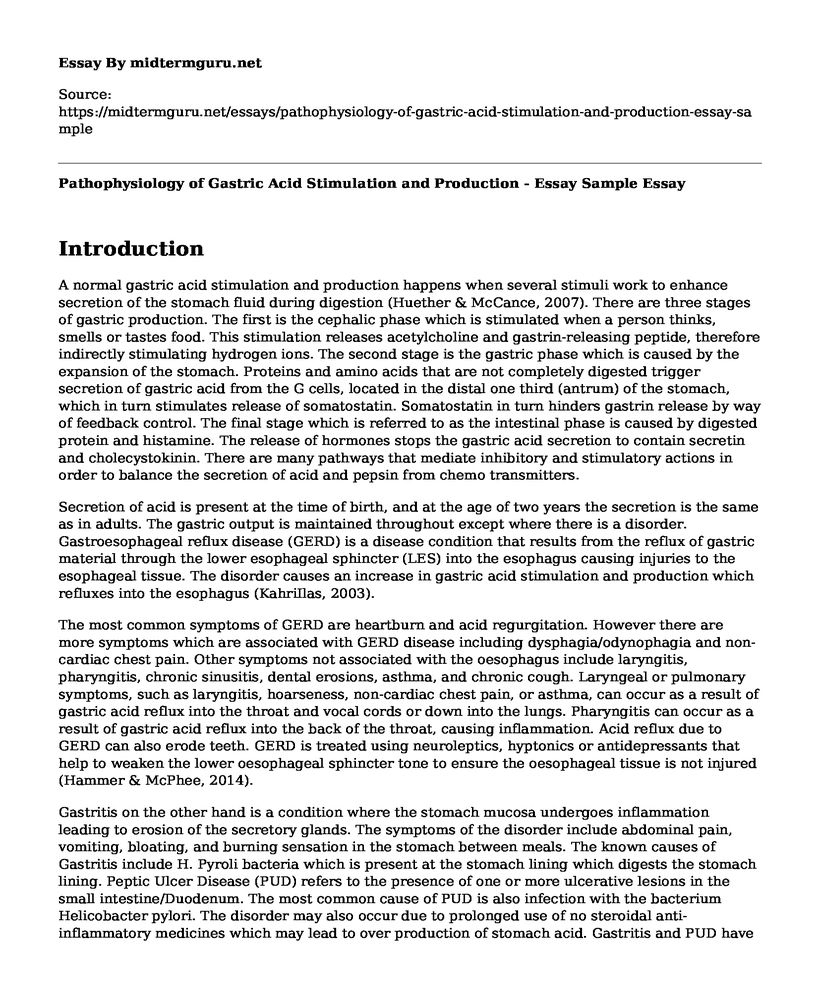Introduction
A normal gastric acid stimulation and production happens when several stimuli work to enhance secretion of the stomach fluid during digestion (Huether & McCance, 2007). There are three stages of gastric production. The first is the cephalic phase which is stimulated when a person thinks, smells or tastes food. This stimulation releases acetylcholine and gastrin-releasing peptide, therefore indirectly stimulating hydrogen ions. The second stage is the gastric phase which is caused by the expansion of the stomach. Proteins and amino acids that are not completely digested trigger secretion of gastric acid from the G cells, located in the distal one third (antrum) of the stomach, which in turn stimulates release of somatostatin. Somatostatin in turn hinders gastrin release by way of feedback control. The final stage which is referred to as the intestinal phase is caused by digested protein and histamine. The release of hormones stops the gastric acid secretion to contain secretin and cholecystokinin. There are many pathways that mediate inhibitory and stimulatory actions in order to balance the secretion of acid and pepsin from chemo transmitters.
Secretion of acid is present at the time of birth, and at the age of two years the secretion is the same as in adults. The gastric output is maintained throughout except where there is a disorder. Gastroesophageal reflux disease (GERD) is a disease condition that results from the reflux of gastric material through the lower esophageal sphincter (LES) into the esophagus causing injuries to the esophageal tissue. The disorder causes an increase in gastric acid stimulation and production which refluxes into the esophagus (KahriIlas, 2003).
The most common symptoms of GERD are heartburn and acid regurgitation. However there are more symptoms which are associated with GERD disease including dysphagia/odynophagia and non-cardiac chest pain. Other symptoms not associated with the oesophagus include laryngitis, pharyngitis, chronic sinusitis, dental erosions, asthma, and chronic cough. Laryngeal or pulmonary symptoms, such as laryngitis, hoarseness, non-cardiac chest pain, or asthma, can occur as a result of gastric acid reflux into the throat and vocal cords or down into the lungs. Pharyngitis can occur as a result of gastric acid reflux into the back of the throat, causing inflammation. Acid reflux due to GERD can also erode teeth. GERD is treated using neuroleptics, hyptonics or antidepressants that help to weaken the lower oesophageal sphincter tone to ensure the oesophageal tissue is not injured (Hammer & McPhee, 2014).
Gastritis on the other hand is a condition where the stomach mucosa undergoes inflammation leading to erosion of the secretory glands. The symptoms of the disorder include abdominal pain, vomiting, bloating, and burning sensation in the stomach between meals. The known causes of Gastritis include H. Pyroli bacteria which is present at the stomach lining which digests the stomach lining. Peptic Ulcer Disease (PUD) refers to the presence of one or more ulcerative lesions in the small intestine/Duodenum. The most common cause of PUD is also infection with the bacterium Helicobacter pylori. The disorder may also occur due to prolonged use of no steroidal anti-inflammatory medicines which may lead to over production of stomach acid. Gastritis and PUD have common similarities in their symptoms and treatment. Both are symptomized by postprandial heaviness, early satiety, and gnawing, aching or burning epigastric pain. To diagnose either both Gastritis and PUD, a direct visualization of the ulcer on esophagogastroduodenoscopy and H.pyroli detection through biopsy or non -invasive testing is done. The differences in symptoms include that in Gastritis, abdominal pain is experienced shortly after eating whereas in PUD the pain is experienced after a few hours of having a meal. Gastritis may be treated using antacids such as Mylanta, Maalox and Riopan and where H. Pyroli bacteria is present, it is eradicated by antibiotics (Huether & McCance, 2007).
The changes in gastric acid stimulation and production when a person is suffering from GERD, PUD and gastritis conditions, are likely to affect their pathophysiology and severity. The increase of gastric volume during these conditions affects the balance toward pathologic reflux as the normal capacity of the oesophageal mucosa to stand the acid is overwhelmed. Mucosal resistance and oesophageal acid clearance which are protective mechanisms are over powered leading to worsening of the disease. Gastric acid stimulation and production increases the density of Helicobacter pylori in the stomach which also increases mucosal erosion which may result into gastric cancer (Hammer & McPhee, 2014) . The Patient being a three months infant is a happy baby which rules out pain which means her symptoms do not suggest Gastritis or PUD. This leaves me with the possibility GERD condition explains the acid regurgitation.
References
Hammer, G. G., & McPhee, S. (2014). Pathophysiology of Disease: An Introduction to Clinical Medicine. New York: McGraw-Hill Education.
Huether, S. E., & McCance, K. L. (2007). Understanding pathophysiology. St. Louis: MO: Mosby.
Kahrilas, P. J. (2003). GERD pathogenesis, pathophysiology, and clinical manifestations. Cleveland Clinic Journal of Medicine, 70(Suppl_5), S4-S4. doi:10.3949/ccjm.70.suppl_5.s4
Cite this page
Pathophysiology of Gastric Acid Stimulation and Production - Essay Sample. (2022, Dec 21). Retrieved from https://midtermguru.com/essays/pathophysiology-of-gastric-acid-stimulation-and-production-essay-sample
If you are the original author of this essay and no longer wish to have it published on the midtermguru.com website, please click below to request its removal:
- Annotated Bibliography on the Relationship Between Single Mothers and Poverty
- Research Paper on ICD-10
- Research Paper on Insulin Suppression Feedback and p13K Inhibitors
- Euthanasia: A Delicate Way to End Suffering and Pain - Research Paper
- Barriers to People With Disabilities in Businesses as Business Owner or As Employee - Research Paper
- Epidemiology of PTSD: Prevalence Across Countries - Research Paper
- My Nursing Career Goals: From Licensure to the Long-Term - Research Paper







